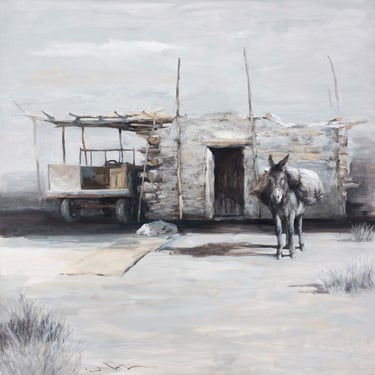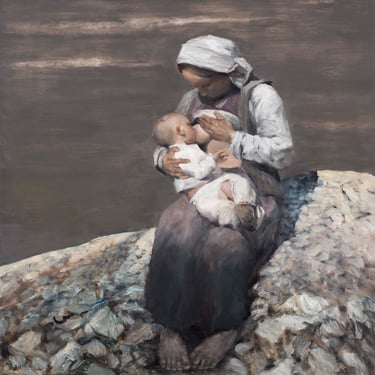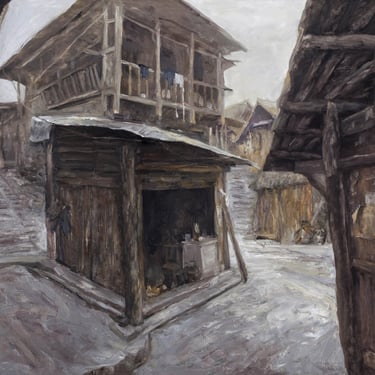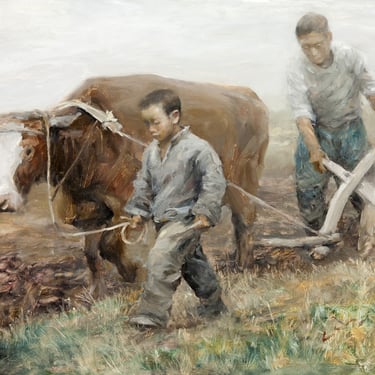Art as the Artist—Cen Long, His Life, and His Paintings
Author | Liu Maoping
10/1/2014
Commenting on Cen Long’s art is, in some ways, easy—his paintings are his life. They encompass everything about him. To understand his art, one simply needs to step into his world. And yet, at the same time, commenting on his paintings is far from easy. His life is so rich, so full, that to truly enter it—to grasp not just his daily existence, but his very being—is an immense challenge. I consider myself fortunate. Through a series of circumstances, I have been able to glimpse his life and, in turn, his artistic soul. Yet when I attempt to put my thoughts into words, I find myself questioning the very act of interpretation. Perhaps his paintings need no explanation at all—for they already speak for themselves.
Still, one must begin by discussing the man himself. In the Biography of Laozi and Han Fei (Laozi Hanfei Liezhuan), there is a well-known account of Confucius consulting Laozi on matters of ritual and propriety. After their meeting, Confucius turned to his disciples and remarked:
“Birds—I know how they fly. Fish—I know how they swim. Beasts—I know how they run. The creatures of the land can be snared in a trap, those of the water caught in a net, and those of the air shot down with an arrow. But as for the dragon—I cannot comprehend it. It rides the wind and ascends to the heavens. Today, I have seen Laozi, and he is like a dragon.”
I have no intention of comparing Laozi and Cen Long, for their paths are entirely different. Laozi renounced earthly desires, whereas Cen Long embraces art with an insatiable passion. He is addicted to smoking, seldom seen without a cigarette in hand—but more than anything, he is addicted to art. He possesses a natural sensitivity and profound love for all forms of artistic expression. Yet, in his simplicity, there is something of the Daoist spirit.
Take his smoking habits, for instance. He does not concern himself with brands or prices—to him, a cigarette is a cigarette, and that is enough. This is not attachment, but rather a natural rhythm of life—a spontaneous act, unburdened by pretense or affectation. In fact, he is the least pretentious person I have ever encountered.
Cen Long’s life experiences are extraordinarily vast, almost impossible to summarize. And yet, rather than making him cunning or worldly, they have only deepened his simplicity. His sincerity is absolute, to the point of almost being naïve. His compassion knows no boundaries—he is utterly without calculation, always willing to help others, often at the cost of his own time and commitments.
His kindness extends not only to people but also to animals. He leaves food for the birds that visit his windowsill, and he once grieved over a single tree branch cut down by a gardener, lamenting the fact that the birds had lost a place to rest.
His life has taken him across France, Japan, and Ukraine. In China, he has experienced life in rural villages, served in the military, worked as a teacher in countryside schools, and even stoked coal for steam locomotives. He later pursued graduate studies, became a professional artist, and taught at universities. But before China’s market economy was fully established, he made a pivotal decision—he left the institutional system to forge his own path, struggling for survival as an independent artist. It is only now that we can finally give him a title: A Free Artist.
Cen Long was an eyewitness to the 85 Art Movement, and in 1987, he participated in the First China Oil Painting Exhibition. His works were also selected for the Seventh and Eighth National Art Exhibitions. Given his experience and reputation, he could have chosen the comfort of an institutional career. With his mastery of painting techniques, he could have continued refining a recognizable style—one that others might have imitated and celebrated.
He had also experimented with various modernist styles, gaining recognition and acceptance. He had the ability and opportunity to fully embrace contemporary art. But he chose neither path.
Instead, he chose to stand firm.
This was not stubbornness, but a deliberate stance—a choice to reflect, explore, and seek. The works presented in this exhibition are the natural fruits of his perseverance and artistic quest.
His paintings retain the spirit of direct observation—a testament to his intimate connection with life. They reflect real, vivid, and deeply felt experiences. While he possesses a profound understanding of Western oil painting techniques, he remains committed to infusing them with a uniquely Chinese essence. And he has succeeded. His brushwork and texture carry a resonance akin to the traditional ink techniques of Chinese landscape painting.
In terms of subject matter, Cen Long’s work is illuminated by a profound sense of humanity. He has consistently focused on the everyday lives of ordinary people, particularly those on the margins of society—rural communities, ethnic minorities, and the underprivileged.
From classical art, we gain aesthetic pleasure and narrative wisdom.
From modern art, we marvel at the purity of form.
In contemporary art, both visual harmony and structured narrative have been abandoned, replaced by an overwhelming spectacle of diversity—one that forces us to reconsider fundamental artistic questions.
Where, then, does Cen Long’s work belong?
As an artist deeply attuned to his time, Cen Long understands contemporary art. Yet, he interprets it in his own way.
With his skills and artistic maturity, he could easily master a wide range of artistic languages and media. However, he once said something to me that was deeply moving:
“Many of my old friends are not well-versed in art. And yet, they still care about my work and share my love for painting. I want to create something they can understand.”
This desire for understanding defines his approach—his works are honest, natural, and deeply human. Clarity of expression, for him, is not a compromise but a deliberate artistic choice.
And yet, his paintings do not shy away from complexity. Through subtle narratives, he raises profound questions about suffering, survival, the land, eternity, centrality and marginality, ethnicity, nationalism, transcendence, and the human condition. His work expresses a deep, unwavering humanism—a concern for the elevation of the soul, an element sorely lacking in contemporary China. It is this humanistic depth that gives his work true contemporary significance.
His paintings may vary visually, but their inner spirit remains constant—a profound empathy that is melancholic yet never despairing. His art is a long, unbroken sigh—the voice of an ancient civilization grappling with the complexities of the modern world.
I have not analyzed individual paintings here, nor do I wish to. Instead, I invite the viewer to enter his work—for in doing so, you will step into the artist’s life itself. And if you truly listen, you may find echoes of your own life—and, perhaps, the fate of an entire people.
— Liu Maoping, Art Theorist, Professor at Hubei Institute of Fine Arts










